华星光电桌面云技术交流V2.0
华为云管端屏幕共享平台使用说明(安卓版)说明书

手机云管端屏幕共享平台使用说明书(安卓版)文件状态:[]草稿[√]正式版本[]正在修改文件标识:当前版本:V2.0作者:客户服务部完成日期:2016-12-29版本历史版本/状态作者参与者修订日期备注V1.0客户服务部张茜、张雪玲2014-4-8新编写V2.0客户服务部唐理理、曾碧琦2016-12-29修改目录一、系统概述 (1)1.系统概述 (1)2.系统优势 (1)二、手机云管端屏幕共享平台功能介绍 (3)1.主要功能介绍 (3)2.操作流程图 (5)3.环境要求 (5)三、手机云管端屏幕共享平台使用说明 (6)1.注册登录 (7)2.用户基本信息 (8)3.终端 (12)4.素材 (16)5.节目 (17)6.授权绑定 (19)7.订单 (20)8.分销 (21)9监播 (21)一、系统概述1.系统概述基于新型的物联网和云计算技术,商巢互联网技术有限公司成功研发了云管端屏幕共享平台网平台。
用户可通过登录云管端屏幕共享平台网平台,提供一站式服务,包括信息发布的管理,资源服务的云交易,快捷的云支付,用户可以在Windows、Android平台上进行高效快捷的信息发布。
云管端屏幕共享平台网平台具有广泛的应用价值,只要应用于室内广告、产品展示、人机互动等领域。
它由服务端统一管理,控制网络内各个终端的播放内容、素材管理、样式管理、任务下发、权限管理等信息。
客服端可实现在一台终端机上播放视频、图片、网页等各种类型的素材的同时,为用户提供个性化的网络触摸信息互动查询系统。
云管端屏幕共享平台网平台分工作组方式的管理模式,且通过中心控制点,可以实现全城乃至全国网点的统一管理、统一发布以及中心控制等功能,其系统的稳定性、显示图像的效果、界面的美观性、内容丰富性、查询网络信息的个性化都是同类产品无法比拟的。
同时系统支持丰富的媒体文件如视频、图片、网页等格式,使该系统成为具备集中化、智能化、易用性等的现代化智能平台,在同类产品中独树一帜。
联想虚拟云终端lvcc2.0管理中心用户手册-2.1

联想虚拟云终端系统(LVCC)V2.1 管理中心用户手册目录联想虚拟云终端系统(LVCC)V2.1 (1)管理中心用户手册 (1)1 概要 (4)2 操作流程 (4)2.1 操作向导 (4)步骤1:创建用户 (4)步骤2:创建桌面 (4)步骤3:创建用户组 (5)步骤4:策略管理 (6)步骤5:登录 (6)2.2 操作关系图 (6)3 管理中心 (7)3.1 用户与安全 (7)3.1.1 用户列表 (8)3.1.2 用户组列表 (13)3.2 管理与监控 (18)3.2.1 连接管理 (19)3.2.2 集群与主机管理 (22)3.2.3虚拟桌面管理 (28)3.2.4终端管理管理 (46)3.3系统维护 (52)3.3.1 系统数据备份 (52)3.3.2 用户数据备份 (53)3.4 系统部署 (55)3.4.1 开启混合模式 (55)3.4.2 系统配置 (56)3.4.3 部署功能列表 (58)3.4.4 部署完成检查 (59)4 用户登录 (60)4.1通过联想云终端登录 (60)4.1.1 登录个人虚拟桌面 (61)4.1.2 登录虚拟桌面池 (62)4.1.3 登录会话桌面 (63)4.2 通过WebAccess登录 (64)4.2.1 登录个人虚拟桌面 (64)4.2.2 登录虚拟桌面池 (65)4.2.3 登录会话桌面 (66)1 概要本文将引导您使用LVCC v2.1管理中心中的操作功能,介绍LVCC v2.1典型应用。
在新的组织或者现有组织中安装LVCC v2.1之前,请确保您的组织和服务器满足LVCC v2.1的要求。
同时,本文也将对管理中心进行详细的功能介绍,操作指导。
以便您和您的团队能够更加高效的使用LVCC v2.12 操作流程2.1 操作向导步骤1:创建用户用户是进行登录、操作的基本单元。
将用户添加到管理中心可以通过三个途径:1.创建用户;2.批量导入用户;3批量创建用户账号。
华星RTK系列软件使用说明书

华星 RTK 系列软件使用说明书
其余设置 ............................................................................................... 60 接收机信息 ........................................................................................... 63 数据调试 ............................................................................................... 64
参数 .............................................................................................................. 66 坐标系统 ............................................................................................... 67 参数计算 ............................................................................................... 73 四参数计算 ........................................................................................... 75 高程拟合 ............................................................................................... 76 点校验 ................................................................................................... 77 点平移 ................................................................................................... 78 导入坐标系统 ....................................................................................... 80
QMosaic-2.0航空影像快速拼接软件操作手册说明书

5244
55
6
6
.2
QMosaic 操作手册
非编辑版
493 110 38 541420. 4312754.5 1889.40 -9.6 -7.1 -89
5676
4
4
.7
494 110 38 541420. 4312857.4 1891.96 -9.1 -7.7 269
2796
41
5
.4
495 110 38 541417. 4312958.4 1890.43 -9.3 -6 267
像片高度,单位为毫米
pos 数据:
表 1 POS 文件示例
影像 经 纬 X坐标
Y坐标
Z坐标 Phi Ome Ka
名称 度 度
ga ppa
434 110 38 541067. 4312958.1 1880.08 -9.7 0.8 87
6371
15
1
435 110 38 541072. 4312853.4 1878.76 -7.9 0.3 87.
Y_Col: 5
POSY坐标所在列
Z_Col: 6
POSZ坐标所在列
Phi_Col: 7
POS旋转角phi所在列
Omega_Col: 8
POS旋转角omega所在列
Kappa_Col: 9
POS旋转角kappa所在列
IsPlane: yes
POS坐标是否是平面坐标
Separator: ""
列与列之间的分隔符,用双引号括起来,默
1.3 输入数据约定
使用 QMosaic 非编辑版航空影像快速拼接软件,创建新的工程,
需要几种不同的数据输入,对于各种输入数据的约定如下:
stellarsupport GreenStar 显示器软件更新 20-1 发布说明 3.36.10
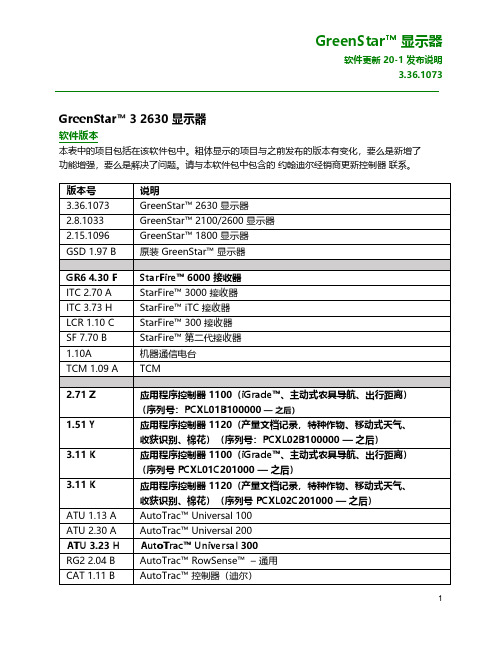
3.36.1073 GreenStar™ 3 2630 显示器软件版本本表中的项目包括在该软件包中。
粗体显示的项目与之前发布的版本有变化,要么是新增了功能增强,要么是解决了问题。
请与本软件包中包含的约翰迪尔经销商更新控制器联系。
3.36.1073重要注意事项:•安装时间取决于现有数据的大小及显示屏上现有的软件版本。
平均总安装时间为 10-15 分钟。
•为了保护自己的数据,建议先备份好显示器的数据,然后再更新软件。
•建议在加载新设置数据前删除GreenStar™ 3 2630 显示器的所有数据,以便移除可能影响显示器性能的不必要的和可能损坏的文件。
•为了确保功能的完整性与正确性,应使用最新版本的GreenStar™ 显示器软件和Apex™ 或首选合作伙伴的桌面软件。
兼容性:•为了确保约翰迪尔机器同步功能正常,GreenStar™ 3 2630 显示器必须安装与之匹配的软件版本。
(推荐使用 18-1 版本)。
•对于约翰迪尔机器同步—覆盖范围图共享功能,在显示器从 SU15-2 升级到任何更新的版本之后,共享的覆盖范围地图将会丢失。
为了避免丢失作业面图,请在农田作业结束后更新软件。
•如果GreenStar™ 3 2630 显示器软件时间从 18-1 倒回到 SU15-2 版本或者倒回到更旧的软件版本,作业面图会丢失。
•ISOBUS AEF 认证功能只能用于 30 系列以及之后的新型拖拉机。
•ISOBUS AEF 认证功能会禁用GreenStar™ 3 2630 显示器内部的虚拟“原装GreenStar™ 监视器”模式以及专门用于“原装GreenStar™ 监视器”模式的控制器。
3.36.1073•在通过显示器重新编程控制器时,打开原装GreenStar™ 监视器模拟器。
对于大多数传统控制器来说,这是必需的。
•第 4 代CommandCenter™ 设置简档不能直接导入到GreenStar™ 3 2630 显示器中。
华星A16智能RTK系统使用说明书

A16 智能RTK系统使用说明书I手册修订情况文件编号:YFZ-2018-2046修订日期修订次数说明2018年5月 1 A16智能RTK系统使用说明书V1.0 I I前言说明书简介欢迎使用华星A16智能RTK使用说明书。
华星A16作为新型GNSS接收机,本说明书对如何安装、设置和使用该产品进行描述。
本说明书适用于华星A16,说明书中示例的图片、图标等与实物有差异,请以产品实物为准。
经验要求为了您能更好的使用华星A16,建议您使用前仔细阅读本说明书。
如果您对华星A16尚不了解,请查阅中海达的官方网站:安全技术提示注意:注意提示的内容一般是操作特殊的地方,需要引起您的特殊注意,请认真阅读。
责任免除使用本产品之前,请您务必仔细阅读本产品使用说明书,以便您能更好地使用本产品。
广州市中海达测绘仪器有限公司对您未按照使用说明书的要求而操作本产品,或未能正确理解使用说明书的要求而误操作本产品所造成的损失不承担责任。
中海达致力于不断改进产品功能和性能、提高服务质量,并保留对使用说明书的内容进行更改而不另行通知的权利。
我们已对印刷品中所述内容与硬件和软件的一致性作过检查,然而不排除存在偏差III的可能性,使用说明书中的图片仅供参考,若有与产品实物不符之处,以产品实物为准。
技术与服务如果您有任何技术问题,可以电话联系各分支机构技术中心、总部技术部,我们会及时的解答您的问题。
相关信息您可以通过以下途径找到该说明书:1、购买华星A16产品后,配赠光盘里有《A16 智能RTK系统使用说明书》,指导您操作仪器;2、登陆中海达官方网站,在“产品”→“RTK产品”→“华星A16”→“相关下载”里即可下载该电子版说明书。
您的建议如果您对华星A16产品有什么建议和意见,请联系我们,或者拨打全国热线:400-678-6690。
您的反馈信息对我们产品的质量将会有很大的提高!I V目录概述 (1)引言 (2)产品特色 (2)产品介绍 (3)整机外观 (4)上盖 (4)下盖 (4)前面板 (6)按键与指示灯 (6)按键功能 (6)指示灯功能 (7)触控显示功能 (7)状态界面 (7)待机界面 (9)设置界面 (9)WEB管理系统 (10)主菜单 (10)信息查看 (12)工作模式 (14)文件管理 (16)固件管理 (16)系统设置 (17)主机云服务 (19)登录服务器 (20)远程注册 (20)远程设基站 (21)静态测量 (22)静态模式设置 (22)静态测量步骤 (22)静态数据下载 (23)V倾斜测量 (24)星站差分 (24)注册授权 (25)使用设置 (26)数据采集 (26)固件升级 (27)USB数据线升级固件 (27)WEB UI升级固件 (27)远程在线升级固件 (27)技术参数 (29)技术参数 (30)主机配件 (32)SIM卡安装 (33)数据线 (33)天线 (34)测量基准件 (34)电池及充电器 (34)VI概述本章节介绍:■引言■产品特色C H A P T E R 11概述引言A16是华星品牌新一款高端GNSS接收机,新一代测量引擎,支持星站差分(选配功能),内置4G全网通通讯,采用全新外观设计,镁合金结构,Linux3.2.0操作系统,内置高清OLED显示和电容式触摸屏,是一款极致、智能、轻巧的测量型GNSS 接收机。
诺瓦科技LED透明屏视频处理器Thunderview_V1用户使用手册
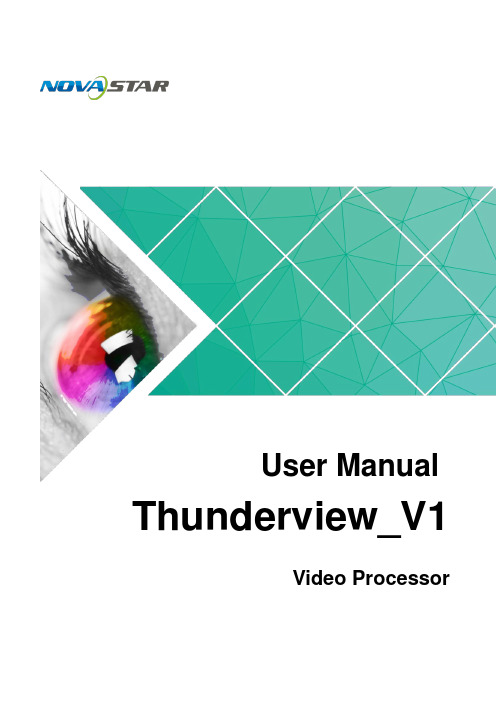
User Manual Thunderview_V1Video ProcessorDocument Version V1.0.0Document Number: NS160110174Copyright © 2017 Xi’an NovaStar Tech Co., Ltd. All Rights Reserved.No part of this document may be copied, reproduced, extracted or transmitted in any form or by any means without the prior written consent of Xi’an NovaStar Tech Co., Ltd.Trademarkis a registered trademark of Xi’an NovaStar Tech Co., Ltd.StatementThunderview_V1User Manualhttp://www.novastar.tech i ContentsContentsYou are welcome to use the product of Xi ’an NovaStar Tech Co., Ltd. (hereinafter referred to as NovaStar). This document is intended to help you understand and use the product. For accuracy and reliability, NovaStar may m a ke improvements and/or changes to this document at any time and without notice. Any problem in use or any good suggestion, please contact us through ways provided in the document. We will do our utmost to solve the problems and adopt the suggestions after e valuation as soon as possible.1O verview (1)2H ardware (2)2.1 Front Panel ..................................................................................................................................................22.2 RearPanel (3)3A pplications (4)4O perations (5)4.1 Home Screen ...............................................................................................................................................54.2 Main Menu ...................................................................................................................................................64.3 Brightness ....................................................................................................................................................64.4 Input Settings ...............................................................................................................................................64.5 Output Settings ............................................................................................................................................74.6 Scaling .........................................................................................................................................................84.7 PIP ...............................................................................................................................................................94.8 Splicing ........................................................................................................................................................94.9 Image Quality .............................................................................................................................................104.10 Advanced Settings ....................................................................................................................................114.11 Factory Reset ...........................................................................................................................................125W eb Control (14)Thunderview_V1User Manualhttp://www.novastar.tech ii1 Overview2 Hardware2 Hardware 2.2 Rear Panel Figure 2-2 Rear panelInput Source Quantity Function SDI2 SDI video source input DP 1 DP video source input 2 Hardware2.1 Front Panel⑦ Custom button: Users can set it to be t he blackout, freeze or test function. ⑧ To display the scaling menu screen⑨ USB: For MCU upgrade1 Overview The Thunderview_V1 is a video processor developed by NovaStar based on the powerful FPGA processing platform. It is designed with various signal inputs, including2 SDI, 1 DP , 1 CVBS, 1 VGA,3 HDMI, 1 DVI and 1 HDBT. It supports input resolutions up to 4096x2160@60Hz and UHD input and output displays. With low latency and a fastsignal source switching within 0.25 second, it can give you a faster operation experience.3 Applications3Applications Figure 3-1 ApplicationThunderview_V1User Manual4 Operations● HDMI3: Currently used input source●PIP − :PIP enabled − : PIP disabled● Scaling− : Scaling function enabled− : Scaling function disabled ● Splicing − : Splicing mode enabled − : Splicing mode disabled ● Genlock − : Genlock enabled− : Genlock disabled ● Brightness− : Current output display brightness4 OperationsOperation instructions Knob: 1 .On the home screen, press the knob to enter the main menu. 2 . On the main menu, rotate the knob to select a menu item. Then, press the knob to confirm the current selected item or to enter the submenu.. 3 When a menu item with parameters is selected, you can rotate the knob toadjust the parameters. Please note that after adjustment, you need to press the knob again to confirm the adjustment.BACK b utton: A return key, used to exit the current menu or operation4.1 Home Screen After the Thunderview_V1 is turned on, the home screen is shown as below.●INPUT : Input source resolution ● OUTPUT : Output source resolutionThunderview_V1User Manual 4 Operations4.2MainMenu 4.3 BrightnessSet the output display brightness which ranges from 0 to 100 and defaults to 50.4.4 Input SettingsInput settings include selecting an input source and setting the EDID of the inputsource.Figure 4-2 Input settingsOn the home screen, press the knob to enter the main menu. On the main menu, rotate the knob to select a menu item. Then, press the knob to confirm the current selected item or to enter the submenu, or press the B ACK button to go back to the previous screen. Functions on the main menu: B rightness , I nput Settings , O utput Settings , Scaling , P IP , S plicing , I mage Quality , A dvanced Settings , and F actory Reset Figure 4-1 Main menuXI'AN● Input Source : 3G-SDI1, 3G-SDI2, DP , HDMI1, HDMI2, DVI, VGA, CVBS, HDMI3, LOGO, HDBT, TESTPAT●Preset Resolution : 640x480p, 720x480i, 720x480p, 720x576i, 720x576p, 800x600p, 1024x768p, 1080x1920p, 1280x720p, 1280x768p, 1280x800p, 1280x1024p, 1360x768p, 1366x768p, 1400x1050p, 1440x900p, 1600x1200p, 1680x1050p, 1920x1080i, 1920x1080p, 1920x1200p, 2048x1080p, 2048x1200p, 2560x1080p, 2560x1440p, 2560x1600p, 3840x2160p, 4096x2160p●Preset Rate : 60Hz, 59.94Hz, 50Hz, 48Hz, 30Hz, 29.97Hz, 25Hz, 24Hz, 23.98HzNote:The logo cannot be loaded through the Thunderview_V1. To load it, perform the following steps.1. Connect the Thunderview_V1 to a PC properly by using an Ethernet cable.2. Ensure that the IP addresses of the PC and the Thunderview_V1 are in the samenetwork segment. 3. Type the IP address of the Thunderview_V1 (http://192.168.0.111) in thebrowser ’s address box and enter the web control page. 4. Click LOGO in the Inputs menu and then click Backup/Restore .5. Click Select file in the Restore settings from files bar. After selection, clickRestore .4.5 Output SettingsOutput settings include setting the resolution and refresh rate of the output source, the aspect ratio and the synchronization mode of the output display. Figure 4-3 Output settings●Output Resolution : 720x576p, 800x600p, 1024x768p, 1080x1920p,1280x720p, 1280x768p, 1280x800p, 1280x1024p, 1360x768p, 1366x768p, 1400x1050p, 1440x900p, 1600x1200p, 1680x1050p, 1920x1080i, 1920x1080p, 1920x1200p, 2048x1080p, 2048x1200p, 2560x1080p, 2560x1440p,− ●− − −Set the scaling of output display, including the dimensions and position of the scaled display.Figure 4-4 Scaling2560x1600p, 3840x2160p, 4096x2160p● Output Rate : 60Hz, 59.94Hz, 50Hz, 48Hz, 30Hz, 29.97Hz, 25Hz, 24Hz, 23.98Hz●Aspect Ratio : Original, Full Screen, Crop, Anamorphic−Original : The input image is scaled to completely fit the display area either horizontally or vertically without any distortion. The input aspect ratio is preserved and unused areas on the top/bottom or left/right are set black. −Full Screen : The input image is scaled to completely fit the display area without preserving the aspect ratio of the source. This will cause distortion but no black areas will be visible.−Crop : The input image is scaled to completely fit the display area whilepreserving the aspect ratio of the source. Portions of the input image on the top/bottom or left/right will be cropped out of the output image.Anamorphic : The image will be treated as in crop, but it is always scaled to a 16:9 aspect ratio.IO Lock : Lock the output displays to be synchronous Off :Disable the synchronous mode.Source : Use an input source as the synchronization signal.Genlock : Use an external Genlock source as the synchronization signal.4.6 Scaling● Scaling : Enable or disable the scaling function.● Scale Value : Unit of scaling, which is pixel or percentage ● Aspect Lock : Enable or disable the aspect lock function ● Zoom H : Horizontal width of the scaled display ● Zoom V : Vertical height of the scaled display ● H Offset : Horizontal position offset ● V Offset : Vertical position offset●Scale Reset : Reset the parameters of scaling.4.7 PIP 4.8 SplicingSet the input source, dimensions and position of PIP . Figure 4-5 PIP● Splicing Zoom : Enable or disable the splicing function.●Splicing Width : Number of screens that are horizontally spliced together ● Splicing Height : Number of screens that are vertically spliced together ● H-Position : Horizontal position on the whole screen of the spliced screen loaded by current device● V-Position : Vertical position on the whole screen of the spliced screen loaded bycurrent device● Advanced Settings− Advanced Enable : Enable or disable the advanced settings. − Start X : Horizontal starting coordinate of the spliced screen loaded by current device− Start Y : Vertical starting coordinate of the spliced screen loaded by currentdevice − Wall Width : Total pixels of the spliced displays at the horizontal direction; ensure that the total pixels of the spliced displays must be the same as the 4.9 Image Quality The Thunderview_V1 is designed with five modes of image quality. Users can also customize templates under the Custom menu item and save them.Figure 4-8 Image quality ● Default : Five pre-stored modes of image quality in the Thunderview_V1− Standard : Parameters such as Contrast , Saturation and Sharpness havehaveSharpnessscreen size. − Wall Height : Total pixels of the spliced displays at the vertical direction; ensure that the total pixels of the spliced displays must be the same as the screen size.Figure 4-7 Splicing mode: 2x2Table 4-1 Explanation by example (Device: H-Position=2, V-Position=1) NOVASTARTECHCO.,LTD.●PIP Enable or disable the PIP function. :● Layout: Choose the position of the PIP . − R+B: PIP at the bottom right of the main window − R+T : PIP at the top right of the main window − L+B : PIP at the bottom left of the main window −L+T : PIP at the top left of the main window− Custom : Customize the position of the PIP in the main window by adjusting the S tart X and S tart Y parameters to move the position.● Main Source Choose the input source of the main window. :● PIP Source : Choose the input source of the PIP . ● Width(W) : Horizontal width of the PIP ● Height(H) : Vertical height of the PIP● Start X : Starting position of the PIP at the horizontal direction●Start Y : S tarting position of the PIP at the vertical direction Set the splicing mode and parameters. Figure 4-6 SplicingXI'AN NOVASTARTECHCO.,LTD.XI'ANNOVASTARTECHCO.,LTD.−Soft : Parameters such as Contrast and Sharpness have the same valuesas those in the Standard mode. The Saturation parameter in this mode hasgreater value than that in the Standard mode.−Outdoor : Parameters such as Contrast and Saturation have greatervalues than those parameters in the Indoor mode. This mode is applicablein the operating environment that has brighter light.−Indoor : Parameters such as Contrast and Saturation have smaller valuesthan those parameters in the Outdoor mode. This mode is applicable in the operating environment that has darker light.● Custom : Customize templates which have four templates in total. ●Current : Display the name of current mode.Note:To modify a template, enter the Template Para menu item and select a targettemplate. Then, press the knob to enter the screen of contrast, saturation and hueadjustment.4.10 Advanced SettingsNote:To exit the test pattern, you need to switch input sources.Figure 4-9 Advanced settings●Display Control : It controls the output display, including Normal , Black Out , Freeze , Test Pattern and Switching Effect .− Normal : The screen normally displays the input contents. − Black Out : The display is blackout. − Freeze : Freeze the current frame.−Test Pattern : Enter the test operation menu.Switching Effect : Set the effects of switching sources, including Fast Fade , Slow Fade and Freeze Fade .●Audio Settings : Audio settings, including setting audio delay, volume and mode.Audio Delay : Audio delay time, ranging from 1 ms to 600 ms ● Fn Settings : Custom button, including the following three functions −Black Out : The display is blackout.− Freeze : Freeze the current frame.−Test : Display the test pattern menu.Thunderview_V1 User Manual4 OperationsXI'ANNOVASTARTECH●Network Settings : Includes setting IP and subnet mask.− Config IPV4: Configure IP manually or automatically.−Reset : Reset the network configuration parameters.● OLED Brightness : Adjust the brightness of the OLED front panel, which ranges from 4 to 15.●Go Homepage(s): A period of time during which the system stops at the current screen and then automatically returns to the home screen when there is no operation performed, which ranges from 29 seconds to 120 seconds and defaults to 30 seconds.● Hardware Version : View the hardware version of the Thunderview_V1. ●Software Version : View the version of the web control page of the upper computer.Note:The IP address of Thunderview_V1 is a fixed one and it cannot be changed.4.11 Factory ResetClear all setting data set by the users and reset the Thunderview_V1 to factory default settings.Figure 4-10 Factory resetNOVASTARTECHCO.,LTD.Thunderview_V1 User Manual5 Web Control5Web ControlWeb control can be performed on a PC or on any mobile phone. No software is required to be installed on the PC. Through web control, all operations that can be performed on the Thunderview_V1 can be performed, including input setting, system setting, audio setting and firmware update.Network ConnectionStep 3 Type the IP address of the Thunderview_V1 (http://192.168.0.111) in the browser ’saddress box and enter the web control page.Web ControlThe web control page is as shown in Figure 5-2.In the top area, Unit ID , Version , and Input Resolution indicate the ID, version and input resolution of current device, respectively. The main menu of the web control page includes the Inputs and MainMenu areas. In the Inputs area, you can switch the input sources. In the Main Menuarea, you can set input sources, output source and other functions. 5 Web ControlFigure 5-2 Main menuCO.,LTD.Step 1 Connect the Thunderview_V1 to a PC properly by using an Ethernet cable.Step 2 Change the IP address of the PC to a static one and type the actual IP address in the corresponding input box. Ensure that the IP addresses of the PC and theThunderview_V1 are in the same network segment.Figure 5-1 Change IP addressXI'ANNOVASTARTECHCO.,LTD.。
维维技术Viavi MTS T-BERD TB8000e V2软件更新说明书

Viavi MTS/T-BERD TB8000e V2Mainframe & BERT ModuleSoftware Update InstructionsSeptember 29, 2017Table of ContentsScope (2)work Upgrade (2)B Upgrade (8)3.StrataSync (13)ScopeThere are three methods to update T-BERD 8000 V2 software:work upgrade - Use this method to update your T-BERD via an Internet connection.B upgrade - Use this method to update your T-BERD with a USB thumb drive.3.StrataSync upgrade - Use this method if your T-BERD 8000 V2 is managed using Viavi’sStrataSync Asset Management system.The T-BERD must be connected to AC Power, regardless of update method.work UpgradeStep Action Details1.Power On Press and hold the ON/OFF button briefly to turn on the T-BERD 8000 V2.2.AC Power Connect the AC power adapter to thepower connector on the right side of theT-BERD 8000 V2.N Connection Connect the Ethernet ManagementPort on the top of the T-BERD 8000 V2to a network connection with internetaccess, using CAT 5E or better cable.4.Home Press the HOME button, at the right side of the display, to display the HOMEscreen selections.work Settings Press the CONNECTIVITY icon and then the ETHERNET icon to displayLAN Settings. Touch on MODE and select DYNAMIC to “DHCP” forautomatic IP address assignment or “Static” for manual input.After configuring LAN settings, press the EXIT button, on the right side ofthe display to exit back to the Connectivity menu.6. Upgrade Press the UPGRADE icon, to display upgrade methods.Set ADDRESS Type to Viavi Server.7.Connect Press SOFTWARE UPGRADE and then UPGRADE VIA ETHERNET.When prompted to confirm the address as pressCONTINUE.You will receive a prompt to wait as it contacts the upgrade server.The unit will present the first selection for Fiber Optics only upgrades. Note that BERT software version is not listed on the right side of the screen.Press the SHOW NEXT CHOICE to proceed to the BERT upgrade.The BERT upgrade version should now be displayed on the right side of the screen. Press CONFIRM THIS CHOICE to begin the upgrade.BB UpgradeStep Action Details Using an internet browser on your PC or laptop, go to /2.8000v2 Click onto display the T-BERD 8000 V2 upgrade portal.3.Download From the second selection labelled Download Latest Combo (Fiber Opticsand BERT) click on the flag icon to download the current software revisionfrom the selected download server. There are choices for North America,EMEA and APAC servers. Save it to your desktop and wait for thedownload to complete.B Stick Insert a USB thumb drive into the USB port on your PC or laptop.5.Extract Open and run the downloaded file, enter the path of the USB stick, and pressto extract files.6.Eject Safely eject the USB drive from your PC or Laptop7.Power on T-BERD Press and hold the ON/OFF button briefly to turn on the T-BERD 8000 V2.8.Power Connect the AC power adapter to the power connector on the right side of theT-BERD 8000 V2.B Connect the USB Thumb Drive to oneof the USB ports on the top of theT-BERD 8000 V2. An 8GB or smallerdrive is recommended.10.Home Press the Home button, to the right of the display, to display the HOMEScreen selections.11.Press the CONNECTIVITY icon and select UPGRADE.12.UpgradeB Upgrade Press Software Upgrade and then Upgrade from USB to display upgradeversions available on the USB stick. Confirm when prompted to display theupgrade information.14.Start Upgrade Press Confirm this Choice to start the upgrade.3.StrataSyncStep Action Details1.Power On Press and hold the ON/OFF button briefly to turn on the T-BERD 8000 V2.2.AC Power Connect the AC power adapter to thepower connector on the right side of theT-BERD 8000 V2.N Connection Connect the Ethernet ManagementPort on the top of T-BERD 8000 V2to a network connection with internetaccess, using CAT 5E or better cable.4.System Press the HOME button, to the right of the display, to display the HOMEscreen selections.work Settings Press the CONNECTIVITY icon and then the ETHERNET icon to displaythe LAN Settings. Touch on MODE and select DYNAMIC to “DHCP” forautomatic IP address or “STATIC” for manual input.After configuring LAN settings, press the EXIT button, on the right side ofthe display, to exit back to the CONNECTIVITY screen.6.StrataSync Press the STRATASYNC icon,, to display StrataSync Settings. Ensure thatAccount ID and Technician ID match those of your StrataSync account.Ensure that the Server Type is set for Viavi Server.7.Sync Press CONNECT TO STRATASYNC to sync your T-BERD 8000 V2 andinitiate upgrades authorized by your StrataSync System Administrator. If anupgrade was assigned to your instrument you will be taken to theUPGRADES menus and you will be asked to confirm the upgrade to start thedownload. If you were expecting an upgrade notification and did not receiveone during your sync to Stratasync, contact your company’s StratasyncAdmin.。
ENTTEC ELM-TouchOSC 远程控制手册说明书

Controlling ELM w/ OSC and TouchOSCCreate a convenient, user-facing control surface for your ENTTEC Pixel systems IntroductionIn this guide we are going to learn how to use the OSC protocol and 3rd party application Touch OSC to create a simple control surface for your ELM pixel system. The goal is to make a user-facing control panel that we can pass to a non-technical end user so they can control their lighting rig, without needing to have a working knowledge of the ELM software.This is a panel with 5 pre-set patterns, and a master intensity control. Using the following steps, you can create a custom control surface as simple or complex as you need.1 - Sample TouchOSC Control PanelCreating the Touch OSC layoutFor this part, you’ll need TouchOSC Editor – which is available from the Hexler website. This app lets you design your control surface on a computer, and then transfer that over to your tablet/phone.When you open the editor, you will see a blank black box representing your device screen. Begin by naming this screen and selecting the screen size.TouchOSC editor has multiple pre-set sizes applicable for Apple devices, for many smart phones the iPhone 6 plus is a close match. Alternately you can enter your own custom values to match the screen resolution of your device.3 - TouchOSC Editor Screen Size Selector4 - TouchOSC Editor Screen Size Options2 - TouchOSC EditorNext, you will need to add a fader to control intensity in ELM. To do this right click anywhere on the black space of your layout. A drop-down list will appear with of all the elements you can add. In this case select a vertical Fader (Fader V).Now you can position it where you want and scale it with the re-size markers on the corners and sides. You can also change the colour and name of your element, allowing for quick and easy identification. Be sure to check the inverted button to ensure your fader moves in the expected direction.The layout builder always shows elements with the value of 0 so if the solid bar is at the top it will need to be inverted.Once you are happy with the position, you can now configure the OSC command string. Touch OSC tries to create default strings based on the item’s name. You will need to uncheck this allowing you to enter 5- Add Element6 - Format Element7 - Element Colour Changeyour own string. Consult the ELM user manual or the convenient list in ELM under the OSC remote settings page.For Intensity you will need to enter “/elm/stages/Stage01/live/intensity”. Leave light and low values as they are.Note – the OSC string is caps sensitiveNote – Stage01 refers to the stage you want to control. If you named your stage something different then you need to use that instead. You can also use * to refer to all stages this would look like “/elm/stages/*/live/intensity”8 - Configure Command String9 - ELM OSC Command StringsNow that you have made your intensity fader, you can move on to making buttons to select the media you want to send. A push button is recommended for this. Select it from the same menu used for selecting your fader.Re-size and move it to a suitable place on your control panel.As before you now need to set the OSC command for the new button This is like setting the intensity.Enter “elm/stages/Stage01/live/media” then in the value boxes set them both to be the same. Thisbutton will be selecting media slot 1 so set both the high and low values to be 1. If the low value is left at 0 it will act as a momentary switch, only activating the media while the button is held downNext move on to the remaining 4 buttons. This can be done by repeating earlier steps, however, it is much faster to copy the button you have just made and paste it down. This also makes sure all your buttons are the same size and shape. Any copy and pasted buttons then just need their high and low valued updated to select a new piece of media so the second buttons high and low values should be set to 2, button 3 to 3 etc.Adding labels is another useful way to keep track of what each element does. These are created in the same way as all other elements. Right click on the black space and select from the drop-down menu as needed.The text and size can also be edited from the side menu just like other elements.10 - Create Push Button Element11 - Setting Command String on Media Button12 - Insert Label13 - Adjust LabelFinally tidy up your screen using the align and distribute tools. These are great for giving your space a clean, user-friendly look. Access these by selecting multiple elements, ‘drag and draw’ over the targets and then right clicking an element. You can then select the desired tools from the drop-down menu. Once you are happy with your layout, save it and then transfer it over to your phone or tablet, so we can later set this as our layout screen. We’ll also show you how to import this directly from your computer a bit later on.14 - Align ElementsConfiguring ELM for an OSC RemoteYou can now shift your attention to the ELM software to prepare it for receiving OSC commands. Open ELM and make your stage using the same name that you have specified in Touch OSC editor (remembering it is case sensitive).Then navigate to the OSC remote settings. Path – Settings>Remote>OSC. Simply turn the switch to ON to allow ELM to receive OSC commands.15 - ELM - Create Stage16 - ELM OSC TabELM-TouchOSC Remote Control – V1For the latest version visitthe ENTTEC websiteFrom here you just need note down the port that is being used. The default is 9001 but you can change it if desired. Feedback can be left off as it is not needed for this design.Note – the complete list of commands for controlling ELM is also listed here so you do not have to gosearching through the user manual.Lastly make sure your media is in the same slots used in your TouchOSC layouts buttons.That’s it, now ELM is set up ready to be able to receive OSC triggers from your phone or tablet.17 - ELM OSC Settings18 - ELM Media SlotsConnecting Your Phone/Tablet to Your ComputerTo connect your computer to your phone, install and run TouchOSC bridge – available from the Hexler website - https:///products/touchoscThis plugin runs in the background and acts as the link between your programs and the TouchOSC app. You also need to know the IP address of the computer for later steps. There are many ways to do this. Depending on how your Pixels have been connected you can get the IP address from ELM by going to your output settings and seeing the IP address of the adapter you are using to send your Art-Net.Another reliable way of getting the IP address of your computer is to open command prompt which can be done by pressing [start] and typing “command prompt”Then simply type “ipconfig/all” and press [ENTER].19 - ELM Output Settings20 - Command PromptThen scroll up till you see the adapter you are using and look for the IPv4 settings.Now we need to open and configure TouchOSC. Open the TouchOSC app on your phone/tablet. When you first open TouchOSC it will show one of the many defaults loaded layouts. To change these settings,simply press the circle in the top right corner of the screen and go to Layout to select your own.3 - IP Config Results22 - Touch OSC Default LayoutClick on the OSC tab, under Settings, from there enter the proper details into the different fields. Some devices will be recognized by the app and you can simply click on them for the app to auto fill the necessary settings. If not, enter the details manually- Host - is the IP Address of your computer, which we previously determined to be 192.168.1.20 -Port (outgoing) - needs to match the port that ELM is expecting to receive on, which as we saw before, defaulted to 9001- Port (incoming) - since our control panel is not receiving any feedback, this setting is irrelevant -ZeroConf Name - you can change this to give your device a unique name23 - ELM OSC Port Setting24 - OSC App SettingsNext the TouchOSC Bridge settings need to be configured. Enter the IP address of the computer inTouchOSC Bridge. As with the OSC tab this will auto discover some computers but if it does not then just enter the IP manually.Once those settings are configured, go back to your computer and TouchOSC editor. Click the sync button and wait for the pop up to appear.Now that the editor is ready to synchronise, switch back to your device running the TouchOSC app, enter the layout menu and select “Add from Editor.” Enter the IP address of the computer running the editor and press download. You can then scroll down the list to find the layout you imported and select it but tapping on it so that it is checked. This is another way to import your layout onto your phone/tablet,besides to just transfer the file across manually.4 - TouchOSC Bridge Setting26 - TouchOSC Bridge Setting27 - TouchOSC Bridge SettingHead back out of the settings on your phone/tablet by using the back arrow and pressing “Done.” You should be able to see and use your layout. You can now freely move the fader, press the buttons, and have ELM respond and reflect your changes on its live tab. You can also check if ELM is receiving OSC by looking to see if the box has gone green in the OSC remote tab.5 - Download LayoutELM-TouchOSC Remote Control – V1For the latest version visitthe ENTTEC website That brings us to the end of this guide, by the end, you’ll have a control panel on your phone or tablet to give you or your client a simple, yet professional control surface for manual control over their pixel mapped setup. And this is just the beginning. With a bit of time and ingenuity you can create even more sophisticated control panels.Check out these sleek control surface examples from the Hexler website:29 – TouchOSC Examples。
桌面虚拟化平台Acer VDI用户手册-3.3

1. 创建和准备虚拟机.........................................................................................................15 2. 桌面池创建.....................................................................................................................15
4.
5. 五、
聚合服务器配置 ............................................................................................................. 12 1) 创建聚合服务器.....................................................................................................12 2) 创建聚合模板.........................................................................................................13 序列号管理 ..................................................................................................................... 13 桌面管理 ......................................................................................................................... 15
华星操作指导
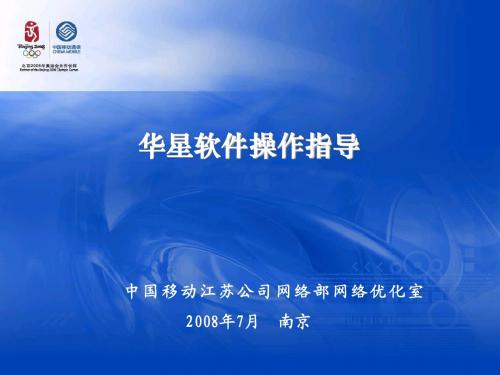
6
测试任务配置
硬件配置好后,打开无线资源管理器的“测试”窗口,选中主叫设 硬件配置好后,打开无线资源管理器的“测试”窗口,选中主叫设 主叫 对于GSM CDMA),来添加测试任务设置。 GSM、 ),来添加测试任务设置 备(对于GSM、CDMA),来添加测试任务设置。
被叫不需要再设置
7
测试任务配置
9
开始测试
以上设置好后, 以上设置好后,点击测试软件的连接设备按钮 ,此时会自动弹出 各视图窗口,如果弹出某设备连接失败,请检查硬件连接及端口号等。 各视图窗口,如果弹出某设备连接失败,请检查硬件连接及端口号等。 设备连接正常, 把测试文件保存到指定位置。 设备连接正常,点击保存文件按钮 ,把测试文件保存到指定位置。 此时测试正式开始。 点击测试按钮 ,此时测试正式开始。 测试正常时,在工作区会显示测试文件的大小, 测试正常时,在工作区会显示测试文件的大小,并处于逐渐变大的 状态。电话拨通后,MOS测试窗口开始录放音 如下: 测试窗口开始录放音, 状态。电话拨通后,MOS测试窗口开始录放音,如下:
17
数据处理
华星软件的统计功能很方便,接通率、掉话率、覆盖率、 华星软件的统计功能很方便,接通率、掉话率、覆盖率、语音质量等关键考核 指标可直接生成结果。见下图: 指标可直接生成结果。见下图:
18
地理化显示
Flywireless地图窗口可以显示接受信号强度Rx分布、接受质量RxQual分 Flywireless地图窗口可以显示接受信号强度Rx分布、接受质量RxQual分 地图窗口可以显示接受信号强度Rx分布 RxQual 时间提前量TA分布、手机发射功率Txpwr LAC分布 TA分布 Txpwr、 分布、 布、时间提前量TA分布、手机发射功率Txpwr、LAC分布、发射方式分类频段 分类及PESQ分布图,同时可以在轨迹上显示事件符号,并且可以显示与服务小 分类及PESQ分布图,同时可以在轨迹上显示事件符号, PESQ分布图 区的连线,以及第二轨迹。 区的连线,以及第二轨迹。
星科技 ARMDUAL 桌面多屏旋转双屏挂架说明书
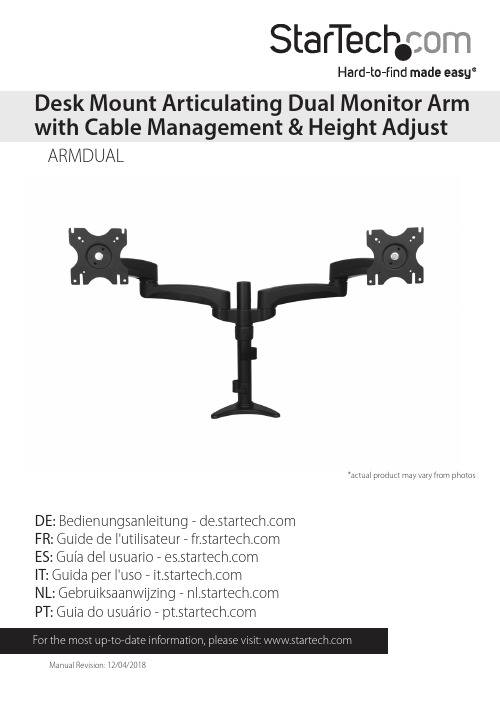
For the most up-to-date information, please visit: ARMDUALDesk Mount Articulating Dual Monitor Arm with Cable Management & Height Adjust*actual product may vary from photosDE: Bedienungsanleitung - FR: Guide de l'utilisateur - ES: Guía del usuario - IT: Guida per l'uso - NL: Gebruiksaanwijzing - PT: Guia do usuário - Use of Trademarks, Registered Trademarks, and other Protected Names and Symbols This manual may make reference to trademarks, registered trademarks, and otherprotected names and/or symbols of third-party companies not related in any way to . Where they occur these references are for illustrative purposes only and do not represent an endorsement of a product or service by , or an endorsement of the product(s) to which this manual applies by the third-party company in question. Regardless of any direct acknowledgement elsewhere in the body of this document, hereby acknowledges that all trademarks, registered trademarks, service marks, and other protected names and/or symbols contained in this manual and related documents are the property of their respective holders.Table of ContentsIntroduction (1)Package contents (1)Product diagram (2)Installation (3)Convert the desk clamp to a grommet clamp (3)Desk or grommet mounting (5)Attach the displays (7)Cable management (10)Adjusting LCD arm resistance (11)Specifications (12)Technical Support (13)Warranty Information (13)Introduction Package contentsLCD arms Qty: Two Dual mountQty: OneDesk clampQty: OneSpacers Qty: Eight M4x12 mm screwsQty: EightM4x25 mm screwsQty: EightGrommet mount M4 Allen keyCover plate assemblyQty: Two Plastic gasket cushionsQty: FourCable clipsQty: TwoInstruction manualQty: One Product diagramInstallationWARNING! The maximum weight capacity of the Dual Monitor Arm is 27.2 kg (60 lbs). Convert the desk clamp to a grommet clampThe Dual Monitor Arm can be clamped to a desk or table, or mounted through a grommet hole. The following instructions outline how to convert the default desk clamp setup to a grommet clamp.1. To disconnect the bottom half of the desk clamp (3), use the M4 Allen key (8) to remove the two hex screws from the back of the desk clamp.2. To disconnect the top half of the desk clamp (3), use the M4 Allen key (8) to remove the four hex screws from the base of the pole.3. Use the four hex screws that you removed in step 2 to install the grommet mount (7) to the base of the pole.4. Use a Phillips screwdriver to remove the screw and two washers shown, and disconnect the threaded shaft from the base of the desk clamp (3). Slide the plate back onto the shaft.Desk or grommet mounting1. Adjust the height of the desk clamp (3) to fit your desk surface (if applicable). The clamp can be extended up to 75 mm (3 in.).2. Place the four plastic gasket cushions (11) as shown.3. Depending on the type of mount you are using, do one of the following:• Desk clamp: Place the desk clamp (3) opening around the edge of yourdesktop in your desired location and tighten the clamp by hand to secure it to the table. Ensure that the desk clamp (3) is making full contact with the desksurface.• Grommet clamp: Place the base of the unit over the grommet hole andthread the clamp into the grommet mount (7) until the clamp holds firmlyagainst the bottom of the desk.Attach the displays1.2. Attach each of the LCD arms (1) to the dual mount (2).3. Use the M5 Allen key (9) to remove the M6 screws and washers from each of the cover plate assemblies (10).4. Place the remaining cover plate assemblies (10) onto each of the LCD arms (1).5. Reinsert each set of the M6 screws and washers back into their cover plate assemblies, in the same order you removed them, through the bottom of each of the LCD arms (1).6. Use the M5 Allen key (9) to tighten each of the cover plate assemblies.7. Repeat steps 4 and 5 on the other LCD arm (1).8. Place the dual mount (2) and the attached LCD arms (1) attached onto the pole.9. Use the M5 Allen key (9) to tighten the dual mount (2).10. To attach monitors, do one of the following:• If the VESA mount sits flush against the installation surface on the monitor,insert the four M4x12 mm screws (5) through the mounting slots on the VESAmount and into the mounting holes on the back of the monitor.Use a Phillips screwdriver to tighten the screws.• If the VESA mount doesn’t sit flush against the installation surface on themonitor, you need to use the provided spacers. Insert the four M4x25 mmscrews (6) through the mounting slots on the VESA mount, into the fourspacers (4), and into the mounting holes on the back of the monitor.Use a Phillips screwdriver to tighten the screws.WARNING! To avoid damage to your display, do not overtighten the screws and stop immediately if you encounter resistance. Ensure that all spacers and screws being used are the same length and thread type.Cable managementNote: When you attach the cables and route them through the cable management channels, ensure that you leave enough slack to avoid stretching or pulling out the cables when you move the arm.1. C onnect your cables to your displays and position the mounting arm in its fully extended position to ensure that the cables you are using are long enough to allow for proper movement.2. Remove the cable covers from the undersides of the LCD arms (1).3. Run the cables down the LCD arms, leaving enough slack at the arm joints. Reattach the cable covers you removed in step 2.4. While holding the cables against the pole, snap the cable clips (12) over the cables and onto the pole.Adjusting LCD arm resistanceWARNING! Forced movement of the LCD arms or mount brackets without loosening the screws may damage the product or the mounted displays.Always support your display from underneath when making any adjustments to the LCD Arms to avoid damage to the display.Note: For all adjustments outlined below, turning the screw clockwise will increase the resistance, while turning the screw counter-clockwise will decrease resistance.• To increase or decrease the tilt resistance, use the M5 Allen key (9) to adjust the set screw located on the side of the mount bracket joint.SpecificationsTechnical Support’s lifetime technical support is an integral part of our commitment to provide industry-leading solutions. If you ever need help with your product, visit /support and access our comprehensive selection of online tools, documentation, and downloads.For the latest drivers/software, please visit /downloads Warranty InformationThis product is backed by a five-year warranty.In addition, warrants its products against defects in materials and workmanship for the periods noted, following the initial date of purchase. During this period, the products may be returned for repair, or replacement with equivalent products at our discretion. The warranty covers parts and labor costs only. does not warrant its products from defects or damages arising from misuse, abuse, alteration, or normal wear and tear.Limitation of LiabilityIn no event shall the liability of Ltd. and USA LLP (or their officers, directors, employees or agents) for any damages (whether direct or indirect, special, punitive, incidental, consequential, or otherwise), loss of profits, loss of business, or any pecuniary loss, arising out of or related to the use of the product exceed the actual price paid for the product. Some states do not allow the exclusion or limitation of incidental or consequential damages. If such laws apply, the limitations or exclusions contained in this statement may not apply to you.Hard-to-find made easy. At , that isn’t a slogan. It’s a promise. is your one-stop source for every connectivity part you need. From the latest technology to legacy products — and all the parts that bridge the old and new — we can help you find the parts that connect your solutions.We make it easy to locate the parts, and we quickly deliver them wherever they need to go. Just talk to one of our tech advisors or visit our website. You’ll be connected to the products you need in no time.Visit for complete information on all products and to access exclusive resources and time-saving tools. is an ISO 9001 Registered manufacturer of connectivity and technology parts. was founded in 1985 and has operations in the United States,。
SINAMICS智能操作面板2 (IOP-2)操作说明说明书

3.1
警告和注意事项 ................................................................................................................... 9
4 概述 ...................................................................................................................................................... 11
7.7
PID HAND 模式................................................................................................................... 46
智能操作面板 2 (IOP-2)
SINAMICS 智能操作面板 2 (IOP-2)
操作说明
本手册中的变更
1
基本安全说明
2
安全注意事项
3
概述
4
安装
5
设置菜单
6
控制菜单
7
菜单
8
选件
9
技术数据
10
版本 07/2021,固件 IOP-2 V2.7
07/2021, FW V2.7
A5E39549448F AJ
4.1
前言 ....................................................................................................... 11
京华丰云虚拟桌面案例——TCL通力电子
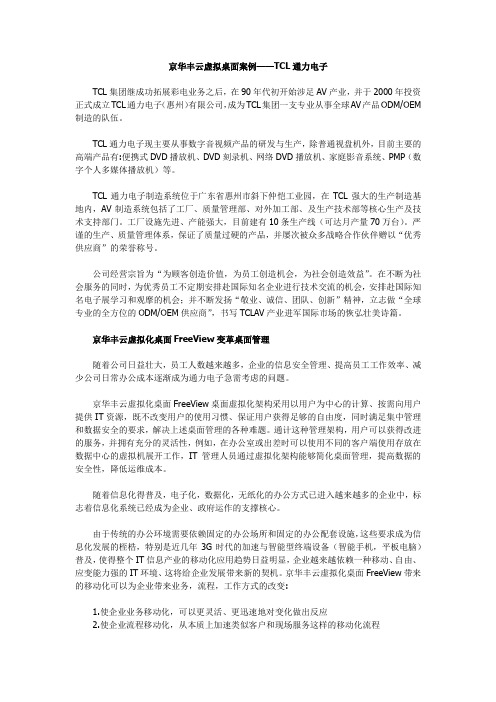
京华丰云虚拟桌面案例——TCL通力电子TCL集团继成功拓展彩电业务之后,在90年代初开始涉足AV产业,并于2000年投资正式成立TCL通力电子(惠州)有限公司,成为TCL集团一支专业从事全球AV产品ODM/OEM 制造的队伍。
TCL通力电子现主要从事数字音视频产品的研发与生产,除普通视盘机外,目前主要的高端产品有:便携式DVD播放机、DVD刻录机、网络DVD播放机、家庭影音系统、PMP(数字个人多媒体播放机)等。
TCL通力电子制造系统位于广东省惠州市斜下仲恺工业园,在TCL强大的生产制造基地内,AV制造系统包括了工厂、质量管理部、对外加工部、及生产技术部等核心生产及技术支持部门。
工厂设施先进、产能强大,目前建有10条生产线(可达月产量70万台)。
严谨的生产、质量管理体系,保证了质量过硬的产品,并屡次被众多战略合作伙伴赠以“优秀供应商”的荣誉称号。
公司经营宗旨为“为顾客创造价值,为员工创造机会,为社会创造效益”。
在不断为社会服务的同时,为优秀员工不定期安排赴国际知名企业进行技术交流的机会,安排赴国际知名电子展学习和观摩的机会;并不断发扬“敬业、诚信、团队、创新”精神,立志做“全球专业的全方位的ODM/OEM供应商”,书写TCLAV产业进军国际市场的恢弘壮美诗篇。
京华丰云虚拟化桌面FreeView变革桌面管理随着公司日益壮大,员工人数越来越多,企业的信息安全管理、提高员工工作效率、减少公司日常办公成本逐渐成为通力电子急需考虑的问题。
京华丰云虚拟化桌面FreeView桌面虚拟化架构采用以用户为中心的计算、按需向用户提供IT资源,既不改变用户的使用习惯、保证用户获得足够的自由度,同时满足集中管理和数据安全的要求,解决上述桌面管理的各种难题。
通计这种管理架构,用户可以获得改进的服务,并拥有充分的灵活性,例如,在办公室或出差时可以使用不同的客户端使用存放在数据中心的虚拟机展开工作,IT管理人员通过虚拟化架构能够简化桌面管理,提高数据的安全性,降低运维成本。
信立讯科技xVDI System I-RDP管理员手册说明书

信立讯科技虚拟桌面系统xVDI System I系统管理员手册(V1.1)文档变化记录成都信立讯科技有限公司目录1关于xVDI System (3)2xVDI System I 解决方案架构 (3)3xVDI System I 虚拟桌面系统部署 (5)3.1xVDI-Server 镜像下载、解压与创建虚拟机 (5)3.2xVDI-Server 软件代码、root及IP地址信息 (6)3.3xVDI-Server 配置 (6)3.4xVDI -Server 服务运行状态验证 (7)3.4.1 查看服务运行情况 (7)3.4.2 查看服务端口 (8)3.4.3 查看运行日志 (8)4xVDI客户端安装与使用 (8)5 无法连接Windows虚拟机的异常处理 (11)5.1 无法连接openstack中的Windows虚拟机 (11)5.2 Windows虚拟机运行性能表现不佳 (13)6xVDI System I的不足之处 (14)7xVDI System II 简介 (14)8xOpenstack-AIO (15)9关于信立讯 (15)10联系信息 (15)1关于xVDI System企业采用PC机作为办公及相关应用前端设备的模式,除了运维方面的麻烦以及技术进度而致使前端PC不断面临淘汰而带来的资金损失以外,还将面临着数据资产无法控制的存取访问所带来的安全风险。
符合摩尔定律、不断发展的强大CPU处理能力已使得企业可以采用虚拟桌面技术来解决当前面临的IT运维复杂、IT资产利用率低以及数据资产外流的问题,即企业可以将员工原PC中的windows/linux系统转而运行于后台高性能服务器中,并通过硬件或软件在前端将桌面映射出来而满足企业办公及相关应用运行要求。
随着信立讯科技在Openstack云系统技术研究的不断进展,我们推出了基于Openstack的xVDI虚拟桌面解决方案及产品,从而使得从一台服务器至数百台服务器规模的、具备良好弹性的虚拟桌面系统成为现实。
屏幕程序烧录指导说明书V2.0

屏幕程序
烧录指导说明书V2.0
目录
1 烧录准备 (3)
1.1 SD卡 (3)
1.2 读卡器 (3)
2 烧录步骤 (4)
2.1 SD卡初始化 (4)
2.2 将要烧录的屏幕程序移动至SD卡 (4)
2.3 烧录程序 (5)
1.1 SD卡
准备一张sd卡,类似于下图所示
1.2 读卡器
准备一个读卡器,类似于下图所示
2.1 SD卡初始化
如果第一次使用SD卡,需要格式化,格式化参数如下:
2.2 将要烧录的屏幕程序移动至SD卡
将完整的程序文件夹复制到sd卡的根目录下(参考U盘复制),例如下图所示:
DWIN_SET 是迪文公司的程序文件夹名。
1. 程序准备好后,先将屏幕断电,然后插入sd卡;
2.屏幕上电,屏幕自动下载烧录sd中的可识别程序。
不同厂家的屏幕烧录完成现象不同,但一般都比较容易分辨,例如有的屏幕程序烧录好后会自动跳转到欢迎界面蜂鸣器响一声,或者蓝屏显示finish、end等信息。
这里以DWIN为例子:
烧录过程,见下图。
烧录成功,屏幕显示“END!”,见下图。
3.屏幕断电,拔出SD卡,屏幕再次接电,就会正常显示程序界面。
Skylion Desktop Pro多投影桌面融合系统中文用户手册
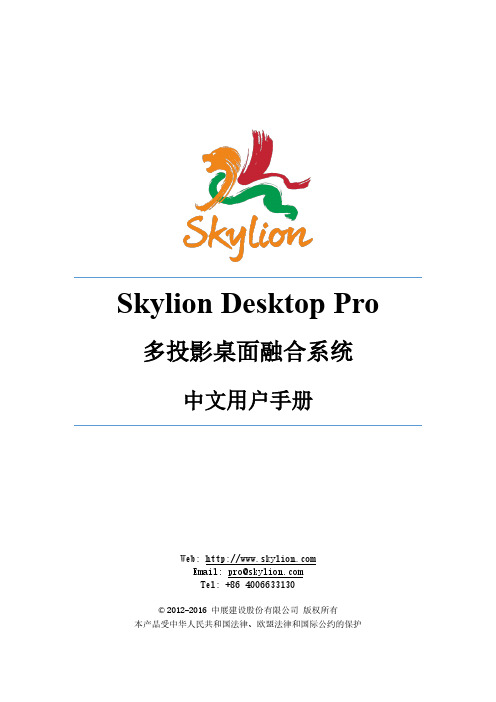
Skylion Desktop Pro 多投影桌面融合系统中文用户手册Web: Email: pro@Tel: +86 4006633130©2012-2016 中展建设股份有限公司版权所有本产品受中华人民共和国法律、欧盟法律和国际公约的保护目录1产品介绍 (2)2系统要求 (3)3安装和卸载 (3)4快速使用向导 (4)5控制面板详解 (10)5.1“信息”选项卡 (10)5.2“显示”选项卡 (11)5.3“偏好”选项卡 (12)5.4“许可证”选项卡 (18)5.5按钮工具栏 (18)6校正和融合配置面板详解 (19)6.1校正和融合介绍 (19)6.2鼠标和键盘控制 (21)6.3配置面板详解 (22)7校正和融合知识 (33)8外部摄像机自动校准 (36)9支持Nvidia Quadro校正与融合 (37)10订购与注册 (38)11许可协议 (40)1产品介绍Skylion Desktop Pro是一个在DirectX、OpenGL环境下对Windows7/8/8.1/10进行桌面级几何校正与边缘融合的系统。
它基于成熟的Skylion几何校正和边缘融合终极技术方案,支持多投影仪投影到规则和非规则的投影屏幕(包括弧形幕、圆柱屏幕、圆顶屏幕以及其他任何形状的屏幕)。
Skylion Desktop Pro利用Skylion核心显示组件进行图像几何校正和边缘融合。
在一个简单的用户界面上,使用鼠标和键盘操作就可以将输出图像映射到任何一种投影屏幕。
调整细粒度和伽玛值对投影图像间重叠边缘进行融合。
每台投影仪的色彩校正可以应用到其他投影仪的配置文件上。
Skylion Desktop Pro支持相机校准文件,相机可以用于自动计算几何校正和边缘融合,使用高清摄像头用户可以创建完美无缝的多投影仪设置。
Skylion Desktop Pro支持每台电脑连接16台投影仪,投影仪可以进行不同的水平和垂直位置叠加摆放。
- 1、下载文档前请自行甄别文档内容的完整性,平台不提供额外的编辑、内容补充、找答案等附加服务。
- 2、"仅部分预览"的文档,不可在线预览部分如存在完整性等问题,可反馈申请退款(可完整预览的文档不适用该条件!)。
- 3、如文档侵犯您的权益,请联系客服反馈,我们会尽快为您处理(人工客服工作时间:9:00-18:30)。
• 增强的 vCenter Orchestrator
• Data Protection • Replication • 无需共享存储的 vMotion • 零停机的 VMware Tools 升级 • vShield Endpoint • 存储 DRS 和配置 文件驱动的存储 与 VCD 配合使用
• 增强的自动部署
Horizon 套件
数据
虚拟桌面
SaaS 应用 虚拟应用 程序
27
远程发布的 Windows应用
未来的发展方向是以用户为中心的计算模式
私有和公共云
数据
VMware
用户工作空间
应用程序 角色
管理控制台
28
议程安排
VMware View 新版本突破与改进
迈瑞VDI环境现状及困境
VMware View的解决之道 VMware愿景——“IT即服务” IBM中国开发中心案例分享 云计算基础架构和管理
优势
利用重复数据消除功能减少磁盘使用空间
数据已消除重复内容并 存储在 VDP 设备上
简单的设置和管理
经验证的技术
23
议程安排
VMware View 新版本突破与改进
迈瑞VDI环境现状及困境
VMware View的解决之道 VMware愿景——“IT即服务” IBM中国开发中心案例分享 云计算基础架构和管理
6
华星光电VDI环境现状及困境
现有VDI架构设计太复杂!
对运维能力要求太高,出现问题也很难排查 系统不够稳定,
经常黑屏
需要管理员从后台强制重启
桌面经常无法连接
用户抱怨不断
“周一上班开启桌面太 慢,几分钟都连不进桌 面”
现有VDI产品对存储IOPS要求太 高,存在启动风暴
“杀毒的时候,桌面我基 本上没法使用”
应用程序 服务
可用性
安全性
可扩展性
VMware vSphere 5
计算 存储 网络
• ESXi 聚合 • 自动部署 • 硬件版本 8 • DRS/DPM
基础架构 服务
• 存储 DRS
• 网络 I/O 控制 (按虚拟机的控制) • 内建分布式交换机 (Netflow、SPAN、LLDP) • 支持第三方分布式交换机 (CISCO Nexus 1000v)
安全
提高现有端点安全解决方案的性能和 效率
将 AV 活动转交给安全虚拟机 (SVM) 提高虚拟桌面的性能 消除桌面代理和 AV 风暴 支持全面桌面虚拟机保护 集中管理跨多个虚拟机的 AV 服务, 并详细记录 AV 活动
SVM
VM
VM
VM
APP
AV
APP
APP
OS
Hardened
OS
4
桌面虚拟化方案三个关注点
1. 增强平台可用性 2. 简化管理复杂度 3. 提升用户满意度
交付
管理
平台
5
议程安排
VMware View 新版本突破与改进
华星光电VDI环境现状及困境
VMware View的解决之道 VMware愿景——“IT即服务” IBM中国开发中心案例分享 云计算基础架构和管理
不支持虚拟化环境无代理防病毒
我们研发设计部门需要用图站,但数据又不安全
VDI进行图形处理一直没能实现!
如何才能发挥VDI的最大价值?
7
议程安排
VMware View 新版本突破与改进
迈瑞VDI环境现状及困境
VMware View的解决之道 VMware愿景——“IT即服务” IBM中国开发中心案例分享 云计算基础架构和管理
37
虚拟化技术原理
VMware 分离了软件和硬件
企业应用程序
操作系统 操作系统
VMware 虚拟化
38
云计算模式和传统IT服务模式的区别
传统IT服务模式 云计算服务模式 虚拟化的资源 服务无边界 自动化的服务管理 标准化的服务 高安全性
• 软件 • 软件 • 服务器 • 存储 • 网络 IT环境以及服务 管理与管控 • 服务器 • 存储 • 网络 IT环境以及服务 管理与管控 软件、服务器、存储、网络 IT环境以及服务管理与管控
优点
轻松为用户实现 3D 应用程序 无需购买物理 GPU 或特殊客户端设备 支持其他使用情形
17
3D图形图像处理VDI解决方案
图形图像
High End CAD Users 3D graphics DirectX instead of OpenGL software decoder (like Google earth)
管理
•物理机角色管理 •角色管理迁移工具 •支持预创建的 AD 计算机帐户 •大规模调整及更多最佳实践 •View Storage Accelerator
简化
•View Composer 阵列集成(技术预览) •针对 NFS 数据存储的集群规模扩展
•独立的 View Composer 服务器
•客户体验改善计划
8
VMware View 体系结构
架构
云计算基础架构
vSphere Desktop
vCenter Desktop
IT 控制
View Manager View Composer View 角色管理 VMware ThinApp vShield Endpoint
终端用户的自由
PCoIP、View Client、 本地模式 优化控制 连续性服务 媒体服务
• 配置文件驱动的存储
• 精简部署模式
• VMFS 5 • 存储 I/O 控制 • 存储API
• 内存优化(内存复用/压 缩/气球释放/磁盘缓存)
40
vSphere 5.1 的新增功能
• 单点登录(vCD、vShield、vCenter) • vSphere Web Client
vCenter Server 5.1
vSphere + vCenter
• 主机配置文件 链接模式 • 虚拟设备 • Web 客户端 • Orchestrator • Update Mgr
• ESXi 防火墙 • VMsafe API • vShield 产品家族 (网络边界到端点防护: 防火墙、静态路由、入侵检测)
• 热添加/ 热插拔 • 动态资源规模调整 • 单个虚机扩展能力 (64 路 SMP、1 TB 内存)
Kernel
OS
Kernel
OS
Kernel
BIOS
BIOS
BIOS
底层扫描
VMware vSphere
22
vSphere Data Protection无代理桌面备份
概述
安全
用于 vSphere 平台的全新备份和恢复工具
VDP
取代 vSphere Data Recovery
VMware vSphere
11
View Storage Accelerator
IO
实现存储访问优化,在提高性能的同时降低存储成本
概述
供公共块读取的内存缓存(基于内容的
读缓存)
适用于所有类型的桌面 客户完全觉察不到 100% 基于服务器 无需特殊的阵列技术
优势
降低存储成本
存储大小可以根据平均工作负载确定
(烟囱式的服务)
极高可扩展性 自助式服务 集约化的资源使用
业务敏捷性受到影响
39
IT 能够跟上业务的节奏
云计算基础架构的核心
vCenter Server •
• 日趋完善的HA体系结构 (硬件、操作系统、应用 ) • 虚机容错技术(FT) • 数据恢复技术(DR) • 在线迁移技术 (vMotion / Storage vMotion)
降低存储上的 IOPS 负载峰值 通过应对最差的使用条件确保一致的用户
体验
允许更多并发用Biblioteka 同时使用相同的资源12示例数据 (1):Windows 7 – 单主机启动风暴
IO
禁用 View Storage Accelerator
• IOPS 峰值降低了约 80% • IOPS 平均值降低了约 45% • 吞吐量峰值降低了约 65% • 吞吐量平均值降低了约 25%
简化管理
操作系统
应用程序
应用程序文件
将应用程序和数据与操作系统分离 避免应用程序冲突 实现应用程序灵活性 实现相同应用程序的多个版本 部署灵活性 端点使用无痕迹
应用程序
应用程序文件
应用程序 沙箱
应用程序 沙箱
可轻松集成到现有 ESD 工具中
VOS
VOS
操作系统
21
通过 vShield Endpoint 简化防病毒管理
13
示例数据 (2):Windows 7 – 多主机启动风暴
IO
“带有 CBRC (View Storage Accelerator) 的 View (Monaco.2) 表现非常出色。重新启动链接克隆池 的速度可提升数小时之多(90 秒内可以启动 60 个虚拟机)” 测试版测试人员观点
IOPS 峰值降低了约 65%
可用性
安全性
自动化
VMware vSphere 5.1
计算 存储
网络
• 硬件版本 9 • 64 路 SMP 1 TB 虚拟机 • VDI 存储空间回收
• 增强的分布式交换机 • SR-IOV 支持
41
Auto Deploy – 自动部署功能增强
2
View 5.1 的三大新增功能特性
1. View Storage Accelerator 2. 大幅提高管理效率 3. 更令人满意的终端用户体验
